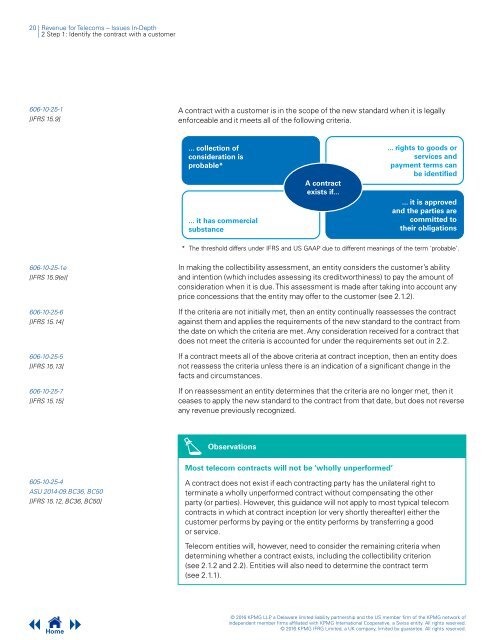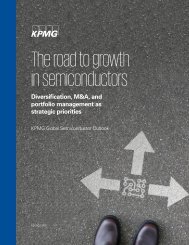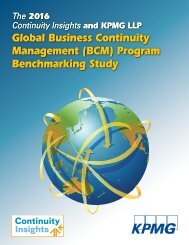Revenue for Telecoms
2cdncba
2cdncba
You also want an ePaper? Increase the reach of your titles
YUMPU automatically turns print PDFs into web optimized ePapers that Google loves.
20 | <strong>Revenue</strong> <strong>for</strong> <strong>Telecoms</strong> – Issues In-Depth<br />
| 2 Step 1: Identify the contract with a customer<br />
606-10-25-1<br />
[IFRS 15.9]<br />
A contract with a customer is in the scope of the new standard when it is legally<br />
en<strong>for</strong>ceable and it meets all of the following criteria.<br />
... collection of<br />
consideration is<br />
probable*<br />
... it has commercial<br />
substance<br />
A contract<br />
exists if...<br />
... rights to goods or<br />
services and<br />
payment terms can<br />
be identified<br />
... it is approved<br />
and the parties are<br />
committed to<br />
their obligations<br />
* The threshold differs under IFRS and US GAAP due to different meanings of the term ‘ probable ’.<br />
606-10-25-1e<br />
[IFRS 15.9(e)]<br />
606-10-25-6<br />
[IFRS 15.14]<br />
606-10-25-5<br />
[IFRS 15.13]<br />
606-10-25-7<br />
[IFRS 15.15]<br />
In making the collectibility assessment, an entity considers the customer’s ability<br />
and intention (which includes assessing its creditworthiness) to pay the amount of<br />
consideration when it is due. This assessment is made after taking into account any<br />
price concessions that the entity may offer to the customer (see 2.1.2).<br />
If the criteria are not initially met, then an entity continually reassesses the contract<br />
against them and applies the requirements of the new standard to the contract from<br />
the date on which the criteria are met. Any consideration received <strong>for</strong> a contract that<br />
does not meet the criteria is accounted <strong>for</strong> under the requirements set out in 2.2.<br />
If a contract meets all of the above criteria at contract inception, then an entity does<br />
not reassess the criteria unless there is an indication of a significant change in the<br />
facts and circumstances.<br />
If on reassessment an entity determines that the criteria are no longer met, then it<br />
ceases to apply the new standard to the contract from that date, but does not reverse<br />
any revenue previously recognized.<br />
Observations<br />
Most telecom contracts will not be ‘wholly unper<strong>for</strong>med’<br />
605-10-25-4<br />
ASU 2014-09.BC36, BC50<br />
[IFRS 15.12, BC36, BC50]<br />
A contract does not exist if each contracting party has the unilateral right to<br />
terminate a wholly unper<strong>for</strong>med contract without compensating the other<br />
party (or parties). However, this guidance will not apply to most typical telecom<br />
contracts in which at contract inception (or very shortly thereafter) either the<br />
customer per<strong>for</strong>ms by paying or the entity per<strong>for</strong>ms by transferring a good<br />
or service.<br />
Telecom entities will, however, need to consider the remaining criteria when<br />
determining whether a contract exists, including the collectibility criterion<br />
(see 2.1.2 and 2.2). Entities will also need to determine the contract term<br />
(see 2.1.1).<br />
Home<br />
© 2016 KPMG LLP, a Delaware limited liability partnership and the US member firm of the KPMG network of<br />
independent member firms affiliated with KPMG International Cooperative, a Swiss entity. All rights reserved.<br />
© 2016 KPMG IFRG Limited, a UK company, limited by guarantee. All rights reserved.







